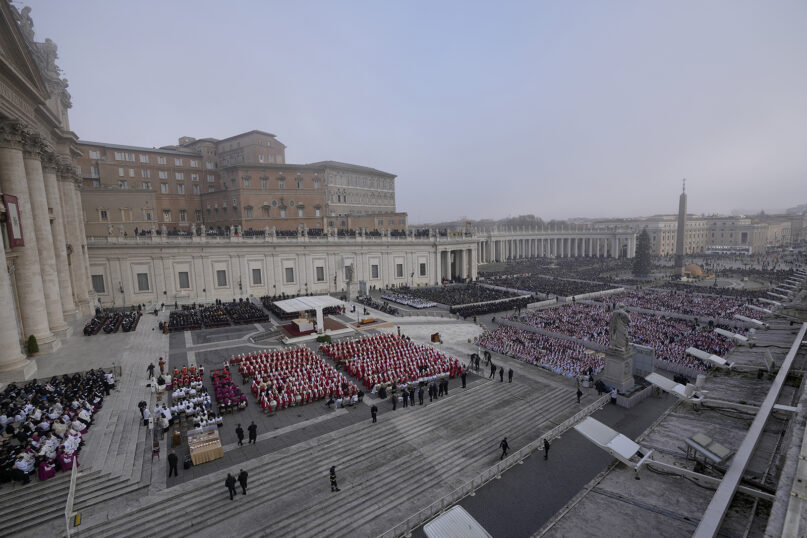
VATICAN CITY (RNS) — New simplified procedures for the funerals of popes were released earlier this month, reflecting Pope Francis’ ongoing effort to emphasize the pope’s role as a pastor.
After witnessing the funeral service for his predecessor, Emeritus Pope Benedict XVI, in 2023, Francis asked the Vatican’s master of ceremonies, Monsignor Diego Ravelli, to review the papal funeral rites. The new rules were approved in April, and Francis was given a copy of the book on Nov. 4.
The 87-year-old pope has said on more than one occasion that the pope’s life — and death — should uphold the values of poverty and humility exemplified by Jesus and encoded in many religious orders’ rules of life.
The revised funeral rites for popes — officially the Ordo Exsequiarum Romani Pontificis — will employ simpler language, and the tradition of encasing the body in three successive coffins of different materials will be ended. The new rules also provide guidelines for burying popes who choose not to be entombed in St. Peter’s Basilica, the traditional resting place, accommodating Francis’ intention to be buried in the Basilica of St. Mary Major, two miles away from St. Peter’s in Rome.
Francis has a special devotion to the Virgin Mary and to the Basilica of St. Mary Major especially, which he used to visit when he would come to Rome when he was still archbishop in Argentina. The pope makes sure to stop and pray before the painting of Mary in the Basilica before, and after, every papal trip and on other special occasions.
In “The Successor: My Recollections of Benedict XVI,” a book of interviews with Spanish journalist Javier Martinez-Brocal, Francis voiced his distaste for the fanfare of pompous practices used during papal funerals and stated that he would like his own funeral to “be like that of any other Christian.”

Faithful attend the funeral Mass for Emeritus Pope Benedict XVI in St. Peter’s Square at the Vatican, Jan. 5, 2023. (AP Photo/Ben Curtis)
The new edition of the funeral rites is an update of the protocols previously approved by Pope John Paul II, which were used with some adaptations for Benedict’s funeral. They, too, simplified and streamlined procedures for papal funerals, part of a trend that started in the 20th century as the popes’ political authority declined after the Vatican lost the papal states.
Ravelli told Vatican news outlets on Wednesday that the goal of the reform is to make the pope’s death more evocative of the death of a pastor or a bishop of Rome than that of “one of the powerful in this world.”
Among the most notable changes in the service, it will no longer refer to the pope by his former grandiloquent titles and will mostly use the Latin words for “pope” and “bishop” and “pastor.” The confirmation of the pope’s death, usually made by the camerlengo, or papal chancellor, will now take place in the papal chapel and no longer in the pope’s rooms.
The current camerlengo is U.S. Cardinal Kevin Joseph Farrell, who is charged with overseeing the Holy See between the death of a pope and the election of another.
The new rules stipulate that the pope’s body will be immediately placed in a simple, zinc-lined wooden coffin before being moved to the Basilica of St. Peter. The customary stop at the Apostolic Palace has been eliminated in the new reform, and there will only be one vigil over the body instead of two.

The coffin of Emeritus Pope Benedict XVI is prepared for burial at the Vatican, Thursday, Jan. 5, 2023. (Vatican Media)
At the basilica, mourners will have an opportunity to pay their respects to the deceased pontiff, who will no longer be displayed atop a temporary wooden structure called a catafalque. The papal staff will no longer be displayed at his side as he lies in state. At the basilica, the coffin will be closed, and there will be a customary funeral Mass.
At the final station, the burial location, the coffin will no longer be placed inside the three coffins made of cypress, lead and oak, making the ceremony much shorter.
Most popes from the past are buried beneath St. Peter’s Basilica, but Francis requested new protocols on how to move the pope’s casket to another place of burial, to smooth his own removal after death to St. Mary Major.
